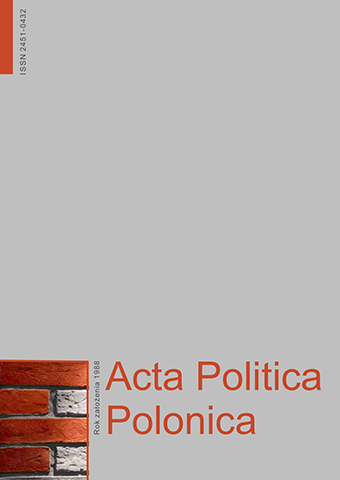
ISSN: 2451-0432
OAI
DOI: 10.18276/ap.2018.45-02




Issue archive /
3/2018 (45)
Etniczność jako instrument oddziaływania społecznego w polityce Wolnościowej Partii Austrii
(Ethnicity according to the Austrian Freedom Party)
| Authors: | Ewa Godlewska |
| Keywords: | Austrian Freedom Party national minority immigrants populism |
| Data publikacji całości: | 2018 |
| Page range: | 10 (19-28) |
Abstract
Austria belongs to countries with a stable party system. The Social Democratic Party of Austria (Sozialdemokratische Partei Österreichs/SPÖ) and the Austrian People’s Party (Österreichische Volkspartei/ÖVP) play a key role. The Austrian Freedom Party (Freiheitliche Partei Österreichs/FPÖ) is the formation which in the last dozen or so years has been increasingly accentuating its presence on the Austrian political scene. This article is an attempt to show the reasons for the current electoral successes of the Austrian Freedom Party and their consequences. The analysis undertaken in the article will allow verification of the thesis, according to which the party of today’s successes owes above all to the slogans directed against national minorities and immigrants, thus referring to the ethnic homogeneity of the Austrian nation.
Download file
Article file
Bibliography
| 1. | Antoszewski A., Herbut R. (red.) (1999). Partie i systemy partyjne. Kraków: Zakamycze. |
| 2. | Bundesgesetz (1976). Bundesgesetz über die Rechtsstellung der Volksgruppen in Österreich (Volksgruppengesetz). BGBl 396/1976. |
| 3. | FPÖ (2005). Das Parteiprogramm der Freiheitlichen Partei Österreichs. Mit Berücksichtigung der beschlossenen Änderungen vom 27. Ordentlichen Bundesparteitag der FPÖ am 23. April 2005 in Salzburg. Pobrane z: http://fpoe¬-timelkam.at/wp-content/uploads/2017/03/FPOE_Parteiprogramm.pdf (10.04.2018). |
| 4. | FPÖ (2011). Parteiprogramm der Freiheitlichen Partei Österreichs (FPÖ). Beschlossen vom Bundesparteitag der Fre¬iheitlichen Partei Österreichs am 18. Juni 2011 in Graz. Pobrane z: https://www.fpoe.at/fileadmin/user_upload/www.fpoe.at/dokumente/2015/2011_graz_parteiprogramm_web.pdf (10.04.2018). |
| 5. | FPÖ (2017). Österreicher verdienen Fairness. Freiheitliches Wahlprogramm zur Nationalratswahl 2017. Pobrane z: https://www.fpoe.at/fileadmin/user_upload/Wahlprogramm_8_9_low.pdf (10.04.2018). |
| 6. | FPÖ Bildungsinstitut (2017). Info-Kompakt, Die Freiheitliche Partei Österreichs (FPÖ). Geschichte, Programm, Or¬ganisation, Kontakte. Pobrane z: https://www.fpoe.at/fileadmin/user_upload/www.fpoe.at/dokumente/2017/Info¬-Kompakt.pdf (10.04.2018). |
| 7. | Gärtner, R. (2002). The FPÖ, Foreigners, and Racism in the Haider Era. W: R. Wodak, A. Pelinka (red.), The Haider Phenomenon in Austria (s. 17–31). New Brunswick: Transaction Publishers. |
| 8. | Godlewska, E. (2011). Ochrona praw grup narodowościowych w Republice Austrii. Lublin: Wydawnictwo Uniwersy¬tetu Marii Curie–Skłodowskiej. |
| 9. | Kosowska-Gąstoł, B. (2010). System partyjny Austrii. W: B. Kosowka-Gąstoł (red.), Systemy partyjne państw Unii Europejskiej (s. 11–26). Kraków: Wydawnictwo Uniwersytetu Jagiellońskiego. |
| 10. | Kraler, A., Sohler, K. (2007). Austria. W: R. Gropas, A. Triandafyllidou (red.), European Immigration. A Sourcebook (s. 19–31). Hampshire: Ashgate Publishing. |
| 11. | Lewica wygrywa… (2015). Lewica wygrywa wybory w Austrii. Pobrane z: http://wpolityce.pl/swiat/268119-lewica¬-wygrywa-wybory-w-austrii (21.04.2016). |
| 12. | Luther, K.R. (2008). Electoral Strategies and Performance of Austrian Right-Wing Populism 1986–2006. W: G. Bischof, F. Plasser (red.), The Changing Austrian Voter (s. 102–120). New Brunswick: Transaction Publishers. |
| 13. | Morawski, R. (2010). Pewne zwycięstwo w cieniu nazistowskich haseł, czyli wybory w Austrii. Pobrane z: http://sto¬sunki.pl/?q=content/pewne-zwyci%C4%99stwo-w-cieniu-nazistowskich-hase%C5%82-czyli-wybory-w-austrii (11.01.2015). |
| 14. | oe24 (2016), Bundespräsidentenwahl. Pobrane z: https://file.oe24.at/center/presidential_2sw/index.oe24.clientHeader. html?apaactualBallot=2 (17.05.2016). |
| 15. | Regierungsprogramm 2017–2022 (2017). Regierungsprogramm 2017–2022. Zusammen. Für unser Österreich. Pobrane z: https://www.bundeskanzleramt.gv.at/documents/131008/569203/Regierungsprogramm_2017%e2%80%932022. pdf/b2fe3f65-5a04-47b6-913d-2fe512ff4ce6 (23.04.2018). |
| 16. | Reiter, E. (1982). Programm und Programmentwicklung der FPÖ. Wien: Braumüller. |
| 17. | Stirnemann A. (1985). Das neue Parteiprogramm der FPÖ– eine kritische Analyse. Österreichisches Jahrbuch für Politik, 657–694. |
| 18. | Zöchling Ch. (2000). Haider, kim jest. Kraków: Biały Kruk. |